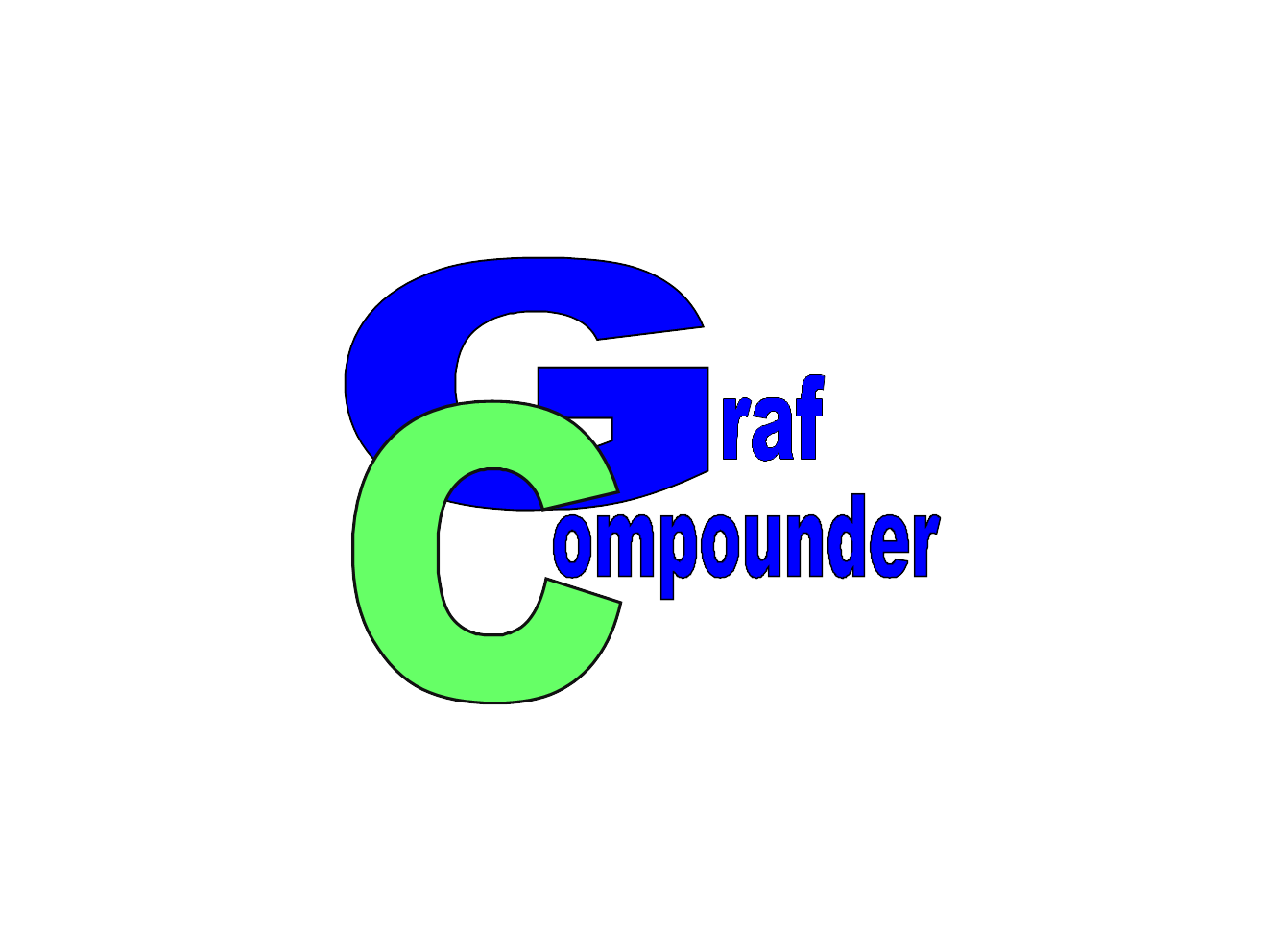GrafCompounder
Artificial Intelligence Software
for Rubber Compounding
Program Description
GrafCompounder is a software tool which calculates recipes for Rubber, TPE, TP and other compounds based on any historic recipe & property library.
GrafCompounder program is developed to calculate and predict mixtures stored in smaller or larger compound libraries. For prediction, few or many targets can be set, such as only basic properties or entire specifications.
GrafCompounder is based on a Feedforward AI (Artificial Intelligence) algorithm with Multi Factor Optimization (MFO), which allows the use of selected data sets of limited size in contrast to neuronal network programs, which require large amount of data.
- GrafCompounder employs a mathematical approach known as 'Multi Objective Optimization' (MOO) or 'Multi Objective Algorithm' (MOA. The calculation results in a solution which represents the best tradeoff between competing objectives. This solution can be achieved through what is known as a Pareto Optimal Solution, using methods like the Weighted Sum, Weighted Metric, or the e-Constraint Method, for example.
- The algorithm handling this kind of multi target problems is called Multi-Objective Evolutionary Algorithm (MOEA). GrafCompounder follows such an evolutionary algorithm, which operates on a set of candidate solutions.
- The software calculates a numeric solution using a gradient walking method. It combines and crossblends all data during the calculation in tiny simultaneous steps in search of a solution for all targets or an optimal compromise.
- During the calculation, a number - the value of the fitness function - is displayed on the screen, which indicates how close the result matches the targets.
- If conflicting targets are present, a perfect solution may not exist, and this is indicated by a fitness function value greater than zero. In this case the resulting solution - compound formula & properties - comes closest to the targets and is displayed, if accepted by the user.
- This predicted compound must be verified in a confirmation experiment. Often the process ends here successfully.
- If it turns out that the specified mixture does not meet expectations, first choice is to modify targets and calculate again. On the other hand you may use this mixture in a Statistic Experimental Design (DoE) as a starting compound for further evaluation.
- This approach is an intelligent way to acquire more knowledge about how ingredients affect the properties of this compound and expand your database.
- Many laboratory tests can be avoided in the search for a statistically sound solution if GrafCompounder is combined with Statistic Experimental Design (DoE), because the development goal is achieved much faster in comparison with any Trial&Error or One Step a Time (OFAT) method.
- The GrafCompounder enables you to analyze your database and identify faulty
compound data, because it allows to identify each compound recipe with its ratio the calculated compound is composed of.
- This program feature is extremely helpful, if your confirmation experiment will result a difference with the calculated compound properties larger than the 95% confidence interval.
- With a database containing sufficiently high amount of compounds, you are able to use the GrafCompounder as a compound simulation and prediction tool.
GrafCompounder 5.0 Tutorial Series

Discover the ins and outs of GrafCompounder 5.0 with our comprehensive tutorial series. Whether you're working with the pre-installed dataset or importing your own, these tutorials are crafted to suit your needs.
Part I: Mastering Compound Predictions
In this GrafCompounder 5.0 Tutorial Part I explore every essential function as we guide you from dataset initialization to the calculation of your first predicted compound. This tutorial lays the foundation for your exploration and sets the stage for the confirmation trial.Part II: Deploying the power of Graphics
Reveal the second part of our tutorial series GrafCompounder 5.0 Tutorial Part II focusing on the practical graphic tools within GrafCompounder 5.0. Learn how to leverage these visuals to analyze unknown databases effectively. Uncover insights, identify anomalies, and streamline your data by eliminating discrepancies.
Part III: Expanding your Data with Data Import
Learn data merging with GrafCompounder 5.0 Tutorial Part III in our latest tutorial installment. From essential merger insights to organizing data and incorporating external tables.- Before You Start: Get a head start with crucial pre-merger considerations.
- OrganizingData for Merger: Master structuring data for flawless integration.
- Incorporating External Tables: Learn the ropes of importing data from external calculation programs.
- Merger of GrafCompounder Files: Explore the nuances of merging internally generated data files.
GrafCompounder: Tips&Tricks
In order to expand the information in the tutorials, I have startede a series of reports, which I call GC Tips&Tricks.
It will show practical examples of how to work with the GrafCompounder.
GC Tips&Tricks No VII: What Process Aids Are Really Doing. The effect of a zinc salt in a viscosity measurement device has its reflection in pressure loss in an injection molding machine and finally affects the Modulus. It can be visualized with a GrafCompounder 3D graph.
GC Tips Tricks No VI: Inclusion of Processing Data in Compound Development. Process optimization and formula development done with on software tool like GrafCompounder helps avoiding large amount of trials.
GC Tips Tricks No V: How to visualize the influence of Polymer on Properties. Based on an EPDM Blend in Compound it is shown the use of the 2D diagram and the 3D diagram for this purpose.
GC Tips&Tricks: No. IV: Compound Library: Dynamic Application. As an example a compound library is created with the Dynamic Hardening Factor [VHF]as a constant, while the static modulus [cstat]and the dynamic modulus [cdyn] is changed step-wise.
GC Tips&Tricks: No. III: Comparison of Prediction with DoE software 2nd Order Regression. Even if there are none linear correlations between ingredients and physical properties predictions are of high precision in side confidence interval.
GC Tips&Tricks: No. II: Finding the optimum solution with conflicting targets. High Modulus and a high elongation at break can be seen as a conflicitng target, for example. A calculation will show the compromise. Change of the criteria values and / or setting further criteria you can identify the best compromise for your needs.
GC Tips&Tricks: No. I. Accelerator study. This is an example of a classic test for an AI [Artificial Intelligence] program, where one compound file is taken out of the dataset, but a compound with exactly these properties is created from the remaining datasets.
Previous Versions of
GrafCompounder Tutorials & Videos
GrafCompounder 4.0
With screenshots and comments the GrafCompounder 4.0 Tutorial
guides you step by step through all function of the new GrafCompounder Software Version 4.0.
Using the Demo Data coming with the software it shows how to evaluate, eliminate outliers and improve prediction. It ends with the merger of files, a function to increase the Database if intended.
Working with the GrafCompounder Software from start to first simulation of a compound:
This GrafCompounder 4.0 Tutorial Video 01,
demonstrates the start and basic steps up to the first calculation of a compound formula using the tutorial database implemented in the program.
The GrafCompounder 4.0 Tutorial Video 02 explains how to improve the result of a rubber compound calculation. We learn how to do a query with multiple targets and how to use the tools "Weight" and "Trdoff" to optimize the result.
The recording of a webinar with the title:
"Improving Predictions of Rubber Compound Formulation: GrafCompounder Case Studies"
was organized by TechnoBiz and presented at www.Knowhow-webinars.com. The original version is uploaded on the TechnoBiz Channel.
The short version of this webinar you can view under the link given above.
The recording of a presentation with the title: "Artificial Intelligence versus Design of Experiments" was organized by Chemical Institute Canada (CIC) December 09. 21 and recorded. The record is uploaded on my YouTube Channel. You can view and download the video "AI versus DoE" for your personal use. A pdf file of this presentation you find under "Literature / Presentations" (see below).
A general introduction into GrafCompounder. This video explains what type of tools we use in rubber formula development, how the GrafCompounder Software works and the advantages and limits we face working with a historically grown database.
GrafCompounder 3.0 and older
The merger of data sets from different files is shown in the video: Merge Data Files. In this video the merger is demonstrated with GrafCompounder 3.211. The procedure is valid for the GrafCompounder 4.0 as well.
The Tutorial for the previous Version GrafCompounder 3.211: Tutorial published June 2018. will be further available for download on this website.
The Tutorial for the version GrafCompounder 2.004: Tutorial was published September 2014. This document is still available for download for the user, who needs it.
The recording of a presentation at the Rubber show "GRTE-2018", Bangkok, Thailand, you can view with this link: GrafCompounder: Software Application in Rubber Compounding.
Presentations, Posters, Seminars, Publications
H.-J. Graf, Where we are with Artificial Intelligence & Machine Learning in Rubber Development, Poster presented at RubberCon23, May 11, Edinburgh, GB.
H.-J. Graf, Review of Machine Learning and Experimental Design in Rubber Compounding Paper presented at TireTech 2022 Conference 18th May, Hannover Germany
H.-J. Graf, Artificial Intelligence versus Design of Experiments in Rubber Compounding, Paper presented at the "Chemical Institute of Canada (CIC)", 09 December 2021.
H.-J. Graf, Artificial Intelligence [AI] in Rubber Compounding, Paper presented at the Technobiz Web-Forum:"All about Compounding", May 6th, 2021.
H.-J. Graf, GrafCompounder: Software Application in Rubber Compounding, Presented at 4th GRTE 2018, March 13-15, 2018, Bangkok, Thailand.
H.-J. Graf, Evaluation of Computer Aided Rubber Compound Development, Presented at IRC 2016, October 24-28, 2016, Kitakyushu, Japan
For the first time a whole design of experiment [DoE] is simulated with the GrafCompounder Software. The results are presented at the Tire Tech 2015 by H.-J. Graf, 10.-12. February 2015 in Cologne under the title: CARD - Computer Aided Recipe Development in the session: "Smart Tire Factory."
- H.-J. Graf, C. Sirisinha, P. Pangamol (Mahidol University, Bangkok, Thailand)
Simulation of a statistical experimental design with a new software tool, RFP 04/2016. An overview about the Advantages and further develpopment of the GrafCompounder software [ENG] is given in this short presentation from the authors.
H.-J. Graf, With more Systematic and Computer Aided Compound Development towards a Competitive Advantage [ENG], Rubber Chem Review, India, to be published 2014
H.-J. Graf, Predicitve Data Analysis and Organization of Data in Rubber Compounding [ENG], Paper presented at DKG Sued/Sued West, April 3.-4. 2014, Wuezburg, Germany
H.-J. Graf, A New Tool for a Systematic Development and Improvement of Compounds [ENG], Paper presented at Rubber Division of ACS, 183 Spring Meeting, Akron, OH, April 24. 2013, USA
H.-J. Graf, Simulation Tool in Tire Compound Development using Compound Database [ENG], Paper presented at Tire Industry Tech 2012, 7-8 March, Bangkok, Thailand
H.-J. Graf, Advantage of Compound Development with the PC-program "GrafCompounder" [ENG], Paper presented at Rubber Compounding Asia 2012, 5-6 March, Bangkok, Thailand
H.-J. Graf, Poster: Validation of "GrafCompounder" with Design of Experiment [DoE] Data and Analysis [ENG], Poster presented at Rubber Technology Expo March 2012, Bangkok, Thailand
H.-J. Graf, Methodical Recipe Development: Increases Technological and Economical Advantages [ENG], Paper presented at IRC 2009, June 29 - July 2, Nueremberg, Germany
H.-J. Graf, Methodical Recipe Development: Increases Technological and Economical Advantages [GER], Conference Proceeding at IRC 2009, June 29 - July 2, Nueremberg, Germany
Updated: 09. February 2024

